 Over the past weeks I have been defining 10 categories to use when assessing the value, or lack thereof, of a genealogy. The question is not “Where do I find a list of the ‘good’ or ‘bad’ genealogies,” but “How do I judge whether a genealogy is good or bad?” For the experiment, I am assigning a maximum of 10 points per category with the idea of coming up with numbers that may allow us to compare thousands of genealogies. This is purely my subjective opinion, of course, and numbers by themselves have little meaning without the reasoning behind them, which is why I have included a good deal of reasoning in the examples below – which means it will take me several posts to complete my report. Continue reading Pulling it all together
Over the past weeks I have been defining 10 categories to use when assessing the value, or lack thereof, of a genealogy. The question is not “Where do I find a list of the ‘good’ or ‘bad’ genealogies,” but “How do I judge whether a genealogy is good or bad?” For the experiment, I am assigning a maximum of 10 points per category with the idea of coming up with numbers that may allow us to compare thousands of genealogies. This is purely my subjective opinion, of course, and numbers by themselves have little meaning without the reasoning behind them, which is why I have included a good deal of reasoning in the examples below – which means it will take me several posts to complete my report. Continue reading Pulling it all together
Monthly Archives: March 2018
‘All in the dark’

61 Bowdoin Street, Boston, Sunday, 18 June 1865: Our summer plans are still in abeyance. Dr. & Fred. Gray[2] went down to see what could be done for us at Pigeon Cove,[3] and came back entirely dissatisfied with the place. The best houses there are kept by Mrs. James Edmonds, Mrs. Elisha Edmonds, Mrs. Story, & Mrs. Babson. [The] rooms are small, the terms high, no beach for bathing – bathe in holes off the rocks, and hold on by ropes!! Mrs. Morland,[4] who has boarded at Marion, says it is very hot & sultry there.
I have written to Mrs. Martin at Manchester – but I know she will not take us, and if she does … she will starve us; but that we can bear, I suppose, and guard against. Her house is charming – and I would gladly risk the table for the sake of getting a place for Mary Shober[5] on that lovely Manchester shore; and I think the boys would have a good time too, though they do say Manchester is “played out.” Continue reading ‘All in the dark’
The original Lucy
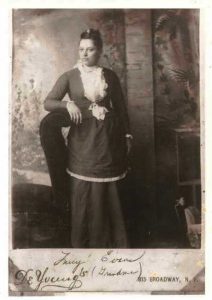 Just when one thought we might be done with John and Lucy Lee…
Just when one thought we might be done with John and Lucy Lee…
When I began to research the life of John E. Lee, I was fortunate when a photograph surfaced purporting to be that of his wife, my great-great-grandmother Lucy Melinda (Nestle) Lee.[1] For me, a photograph of my primordial Lucy was a real prize. Hard to find, it was a photograph procured through more than just my own efforts, thanks to the amazing connections we all make with our distant cousins. Continue reading The original Lucy
‘Marry me’

Oh, Susanna, will you marry me? And she said yes, three times, maybe four! I knew about the first three husbands, but who was the fourth, if indeed there was one?
The Susanna in this question is Susanna Johnson,[1] who married first in 1770 Lieut. Samuel Cony and had five children. After his death in 1779, she married Captain James Howard, a man forty-five years her senior with four children: John, Samuel, Margaret, and William. Then James and Susanna’s two children, Isabella and James, came along, creating a scandal and generations of legal wranglings over inheritance. After James’ death at age 85 in 1787, Susanna said yes again to a marriage proposal from William Brooks,[2] Husband Number Three. Continue reading ‘Marry me’
Skipped out
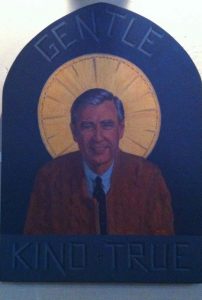
This is a big year for honoring Fred McFeely Rogers, who – if not a family member – was a virtual neighbor to millions of us. The United States Postal Service is issuing a stamp in his memory this week, and I was touched to discover that an “icon” honors him near the pew he habitually occupied in a church my great-great-great-great-grandparents inadvertently helped found in 1838.
However, this story is about a very different Mr. Rogers, the first husband of the second wife of my great-grandmother’s sister’s first husband. Got that? I’ll rewind and explain: my great-grandmother’s sister, Kate Bottomes, married a man named William H. Rardon in 1891. By the 1900 census, Kate was divorced from Mr. Rardon; he married Lillian Vestalina (Roberts) Rogers in 1908. In August 1912, Lillian Rardon got some very interesting news: her first husband, James Wood Rogers, had been killed by government soldiers in Belgian Congo, on 8 October 1911. Continue reading Skipped out
Three Eatons of Watertown
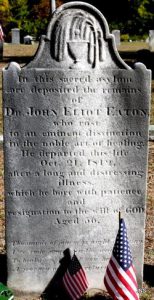
After my recent post on my Eaton ancestors, my aunt e-mailed me, curious to know if “those Eatons” were related to our “other Eatons”? The quick answer is yes, but I don’t know how! Let me explain.
Through my great-grandfather, I descend (in two unique ways, including via the Eaton family of the last post), from the immigrant John Eaton (ca. 1605–1659) of Dedham, Massachusetts. Through my great-grandmother, I descend from Jonas Eaton (ca. 1618–1674) of Reading, Massachusetts (see chart below).
Here is what we know on each Eaton man. Continue reading Three Eatons of Watertown
Accessibility
 Until very recently, the vast and rich world of genealogical publications was limited to those who could visit a library with a specialized collection, such as NEHGS. Most genealogies are, as one would expect, privately published by the author or client in limited numbers. Sometimes only a handful of copies were made and distributed to a few, select libraries, plus a small number of relatives, and that does not even begin to cover manuscript material of all those genealogies that never saw print, or collections of multiple family research by noted genealogists.[1]
Until very recently, the vast and rich world of genealogical publications was limited to those who could visit a library with a specialized collection, such as NEHGS. Most genealogies are, as one would expect, privately published by the author or client in limited numbers. Sometimes only a handful of copies were made and distributed to a few, select libraries, plus a small number of relatives, and that does not even begin to cover manuscript material of all those genealogies that never saw print, or collections of multiple family research by noted genealogists.[1]
The good news, of course, is that this is a case where the Internet has had a positive influence, with nearly every book in the world being digitized and made available online and exploding access to digitized manuscript material from every library and archive to boot.[2] Continue reading Accessibility
Boomerang photos
 I grew up with few pictures from my mother’s side of the family. Her parents, Emory Morse and Lois Rhodes, had been near-neighbors as children in Wareham, Massachusetts. They divorced when my mother was eight. Mother had no further contact with her father until she was 40.
I grew up with few pictures from my mother’s side of the family. Her parents, Emory Morse and Lois Rhodes, had been near-neighbors as children in Wareham, Massachusetts. They divorced when my mother was eight. Mother had no further contact with her father until she was 40.
After my mother’s college graduation, her mother and step-father, a teacher working for the U.S. State Department, announced they had accepted a three-year-assignment in Ethiopia. Mother declined the opportunity to go with them. Instead, she accepted her first job as a clinical instructor and moved into a small apartment. Her family home in Maywood, New Jersey, was rented, with all contents of the house placed in a storage warehouse. Three months later, the warehouse burned – a total loss. Continue reading Boomerang photos
‘The pleasure of his acquaintance’
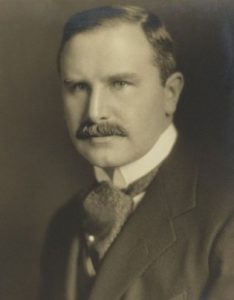
The name Campbell has been a favored first or middle name in the Steward family for the last 170 years; before that it passed down in the White family of Baltimore and New York, where it was still recently in use. It was my great-great-great-grandfather Campbell Patrick White (1787–1859) who seems to have been the first to bear the name as a first name, and perhaps it was his father, Dr. John Campbell White (1757?–1847), who was the first White with the Campbell middle name.[1]
So the Campbells had a name with which to conjure, and according to a nineteenth-century cousin it was thanks to the marriage of Dr. White’s parents, the Rev. Robert White and Jane Thompson, that the name entered the White family. Jane and Robert were cousins, but it was Jane who was “the aunt of Sir John Campbell, Lieutenant General of the Isle of Jersey, and a connection of John Campbell the great Duke of Argyle.” Continue reading ‘The pleasure of his acquaintance’
‘Lovely lady’
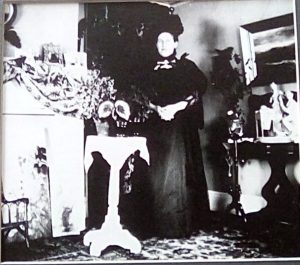 Many posts ago, I bemoaned the fact that I had (and have) many photographs of unknown people, animals, and landscapes. I have always been lucky enough to have all these albums and bins, even if I can’t put names to faces, or labels to albums. I’ve learned a little about how to date clothing and surroundings, hairstyles and hats, and poses and props.
Many posts ago, I bemoaned the fact that I had (and have) many photographs of unknown people, animals, and landscapes. I have always been lucky enough to have all these albums and bins, even if I can’t put names to faces, or labels to albums. I’ve learned a little about how to date clothing and surroundings, hairstyles and hats, and poses and props.
So it was with smug satisfaction and great glee years before reality set in that I retrieved a negative from its tightly curled state. Knowing who it was, I had it developed, and a safety negative prepared. Continue reading ‘Lovely lady’